Modeling Study on Melt Flow, Heat Transfer, and Inclusion Motion in the Funnel-shaped Molds for Two Thin-Slab Casters
Abstract
1. Introduction
2. Geometric Model of EMBr Mold
2.1. Ruler EMBr Configuration
2.2. Computational Domain and Parameters
3. Mathematical Model of EMBr Mold
3.1. Basic Assumptions
3.2. Fluid Flow and Solidification Model
3.3. RANS Turbulence Model
3.4. Inclusion Motion Model
- (1)
- If the molten steel temperature T is lower than the solidus temperature Ts, there is no movement of the inclusions in the solid zone.
- (2)
- If the molten steel temperature T is higher than the liquidus temperature Tl, there are seven forces involved in the movement of the inclusions in the liquid zone.
- (3)
- If the molten steel temperature T is between the solidus temperature Ts and the liquidus temperature Tl, the inclusions penetrate into the mushy zone. In the mushy zone, except for the original seven forces, an additional Marangoni force is applied to the movement of the inclusions.
3.5. Electromagnetic Field Model
3.6. Computational Conditions
4. Validation
4.1. Grid Independence Test
4.2. Electromagnetic Field Model Verification
4.3. Solidification Model Verification
5. Results and Discussion
5.1. Electromagnetic Characteristics in the CSP and FTSR Molds with Ruler EMBr
5.2. Flow and Thermal Characteristics in the CSP and FTSR Molds with Ruler EMBr
5.3. Level Fluctuation Characteristics in the CSP and FTSR Molds with Ruler EMBr
5.4. Solidification Features in the CSP and FTSR Molds with Ruler EMBr
5.5. Inclusion Motion Features in the CSP and FTSR Molds with Ruler EMBr
6. Conclusions
- With the application of the ruler EMBr, the generated magnetic field can directly act on the jet-impingement region in the CSP and FTSR molds. As a result, the excited induced current and electromagnetic force are correspondingly strengthened in this region.
- The bifurcated SEN used in the CSP mold can lead the molten steel to the depth of the molten pool, which is not conducive to the floating removal of inclusions. With the application of the ruler EMBr, when the magnetic flux density reaches 0.5 T, the floatation removal rates of inclusions with a diameter of 100 μm in the CSP mold are only increased to 1.48 percent, when compared to the case of no EMBr.
- The four-port SEN used in the FTSR mold is conducive to improving the uniformity of molten steel temperature distribution on the free surface and promoting the floating removal of inclusions. However, due to the unique design of the upper ports of the SEN, the intensified molten steel surface flow and fluctuation can easily lead to surface slag entrapment. With the absence of EMBr, the maximum surface fluctuation height in the FTSR mold reaches 23.7 mm at a high casting speed of 7.5 m/min.
- With the application of the ruler EMBr in the FTSR mold, the braking effect of the ruler EMBr not only increases the molten steel temperature at the upper ports of the SEN, but also maintains the control of the jet flow discharged from the lower ports of the SEN. As a result, the penetration depth of the jet flow into the molten pool is decreased and the floating effect of the inclusions is improved accordingly. With the electromagnetic parameter of 0.5 T, the floatation removal rates of inclusions with a diameter of 100 μm in the FTSR mold are increased to 4.5 percent, when compared to the case of no EMBr.
- For the ruler EMBr applied to the CSP and FTSR molds, the shell grows slowly in the jet-impingement region along the casting direction, resulting in a slightly thinner shell thickness. However, the shell thickness is still within the safe shell-thickness range.
Author Contributions
Funding
Data Availability Statement
Acknowledgments
Conflicts of Interest
Nomenclature
| p | pressure, [Pa] | FG,i | gravitational force, [N∙m−3] |
| vj | steel velocity, [m∙s−1] | FB,i | buoyancy force, [N∙m−3] |
| μeff | steel effective viscosity, [kg∙m−1∙s−1] | FP,i | pressure gradient force, [N∙m−3] |
| gi | gravitational acceleration, [m2∙s−1] | FD,i | drag force, [N∙m−3] |
| Fm,i | electromagnetic force, [N∙m−3] | FL,i | Saffman lift force, [N∙m−3] |
| FT,i | thermal buoyancy force, [N∙m−3] | FVM,i | virtual mass force, [N∙m−3] |
| Sm | momentum source term | FM,i | Magnus lift force, [N∙m−3] |
| Gk | generation of turbulence kinetic energy | FMa,i | Marangoni force, [N∙m−3] |
| Sk | source term | ||
| Sε | source term | Greek symbols | |
| C1 | coefficient | ||
| C2 | coefficient | ρ | steel density, [kg∙m−3] |
| S | modulus of the mean rate-of-strain tensor | μt | turbulent viscosity, [kg∙m−1∙s−1] |
| Amush | empirical constant in mushy region | k | turbulent kinetic energy, [m2∙s−2] |
| Se | energy source term | ε | turbulent dissipation rate, [m2∙s−3] |
| H | total enthalpy of mushy region, [kJ∙kg−1] | η | strain rate |
| K | steel thermal conductivity, [W∙m−1∙K−1] | σk | turbulent Prandtl number |
| T | steel temperature, [K] | σε | turbulent Prandtl number |
| Tl | steel liquid temperature, [K] | ξ | a constant of 0.001 |
| Ts | steel solid temperature, [K] | ||
| fl | liquid fraction | Subscripts | |
| fs | solid fraction | ||
| bi | induced magnetic field, [T] | eff | effective |
| B0,i | applied magnetic field, [T] | M | magnetic |
| vc | casting speed, [m∙s−1] | T | thermal |
| nc | vector in the direction of casting | m | momentum |
| nf | normal vector to funnel-curved surface | p | particle |
| vs,j | funnel-curved shell moving speed, [m∙s−1] | l | liquid |
| vp,i | particle velocity, [m∙s−1] | s | Solid |
References
- Liu, H.; Yang, C.; Zhang, H.; Zhai, Q.; Gan, Y. Numerical simulation of fluid flow and thermal characteristics of thin slab in the funnel-type molds of two casters. ISIJ Int. 2011, 51, 392–401. [Google Scholar] [CrossRef]
- Zhang, L.S.; Zhang, X.F.; Wang, B.; Liu, Q.; Hu, Z.G. Numerical analysis of the influences of operational parameters on the braking effect of EMBr in a CSP funnel-type mold. Metall. Mater. Trans. B 2014, 45, 295–306. [Google Scholar] [CrossRef]
- Tian, X.Y.; Li, B.W.; He, J.C. Electromagnetic brake effects on the funnel shape mold of a thin slab caster based on a new type magnet. Metall. Mater. Trans. B 2009, 40, 596–604. [Google Scholar] [CrossRef]
- Vakhrushev, A.; Wu, M.; Ludwig, A.; Tang, Y.; Hackl, G.; Nitzl, G. Numerical investigation of shell formation in thin slab casting of funnel-type mold. Metall. Mater. Trans. B 2014, 45, 1024–1037. [Google Scholar] [CrossRef]
- Li, B.; Okane, T.; Umeda, T. Modeling of biased flow phenomena associated with the effects of static magnetic-field application and argon gas injection in slab continuous casting of steel. Metall. Mater. Trans. B 2001, 32, 1053–1066. [Google Scholar] [CrossRef]
- Kim, D.S.; Kim, W.S.; Cho, K.H. Numerical simulation of the coupled turbulent flow and macroscopic solidification in continuous casting with electromagnetic brake. ISIJ Int. 2000, 40, 670–676. [Google Scholar] [CrossRef]
- Qian, Z.D.; Wu, Y.L. Large eddy simulation of turbulent flow with the effects of DC magnetic field and vortex brake application in continuous casting. ISIJ Int. 2004, 44, 100–107. [Google Scholar] [CrossRef]
- Hwang, Y.S.; Cha, P.R.; Nam, H.S.; Moon, K.H.; Yoon, J.K. Numerical analysis of the influences of operational parameters on the fluid flow and meniscus shape in slab caster with EMBr. ISIJ Int. 1997, 37, 659–667. [Google Scholar] [CrossRef]
- Torres-Alonso, E.; Morales, R.D.; Demedices, L.G.; Nájera, A.; Palafox-Ramos, J.; Ramirez-Lopez, P. Flow dynamics in thin slab molds driven by sustainable oscillating jets from the feeding SEN. ISIJ Int. 2007, 47, 679–688. [Google Scholar] [CrossRef]
- Park, J.K.; Samarasekera, I.N.; Thomas, B.G.; Yoon, U.S. Thermal and mechanical behavior of copper molds during thin-slab casting (II): Mold crack formation. Metall. Mater. Trans. B 2002, 33, 437–449. [Google Scholar] [CrossRef]
- Xu, L.; Wang, E.; Karcher, C.; Deng, A.; Xu, X. Numerical simulation of the effects of horizontal and vertical EMBr on jet flow and mold level fluctuation in continuous casting. Metall. Mater. Trans. B 2018, 49, 2779–2793. [Google Scholar] [CrossRef]
- Sun, X.; Li, B.; Lu, H.; Zhong, Y.; Ren, Z.; Lei, Z. Steel/slag interface behavior under multifunction electromagnetic driving in a continuous casting slab mold. Metals 2019, 9, 983. [Google Scholar] [CrossRef]
- Garcia-Hernandez, S.; Gonzalez-Guzman, C.H.; Davila, R.M.; Barreto, J.J.; Gutierrez, E.; Calderon-Ramos, I. Modeling study of EMBr effects on the detrimental dynamic distortion phenomenon in a funnel thin slab mold. Crystals 2020, 10, 958. [Google Scholar] [CrossRef]
- Han, S.W.; Cho, H.J.; Jin, S.Y.; Sedén, M.; Lee, I.B.; Sohn, I. Effects of simultaneous static and traveling magnetic fields on the molten steel flow in a continuous casting mold. Metall. Mater. Trans. B 2018, 49, 2757–2769. [Google Scholar] [CrossRef]
- Sarkar, S.; Singh, V.; Ajmani, S.K.; Singh, R.K.; Chacko, E.Z. Effect of argon injection in meniscus flow and turbulence intensity distribution in continuous slab casting mold under the influence of double ruler magnetic field. ISIJ Int. 2018, 58, 68–77. [Google Scholar] [CrossRef]
- Cukierski, K.; Thomas, B.G. Flow control with local electromagnetic braking in continuous casting of steel slabs. Metall. Mater. Trans. B 2008, 39, 94–107. [Google Scholar] [CrossRef]
- Thomas, B.G.; Singh, R.; Vanka, S.P.; Timmel, K.; Eckert, S.; Gerbeth, G. Effect of single-ruler electromagnetic braking (EMBr) location on transient flow in continuous casting. J. Manuf. Sci. Prod. 2015, 15, 93–104. [Google Scholar] [CrossRef]
- Jin, K.; Vanka, S.P.; Thomas, B.G. Large eddy simulations of electromagnetic braking effects on argon bubble transport and capture in a steel continuous casting mold. Metall. Mater. Trans. B 2018, 49, 1360–1377. [Google Scholar] [CrossRef]
- Wang, Y.; Zhang, L. Fluid flow-related transport phenomena in steel slab continuous casting strands under electromagnetic brake. Metall. Mater. Trans. B 2011, 42, 1319–1351. [Google Scholar] [CrossRef]
- Harada, H.; Takeuchi, E.; Zeze, M.; Tanaka, H. MHD analysis in hydromagnetic casting process of clad steel slabs. Appl. Math. Modell. 1998, 22, 873–882. [Google Scholar] [CrossRef]
- Chaudhary, R.; Thomas, B.G.; Vanka, S.P. Effect of electromagnetic ruler braking (EMBr) on transient turbulent flow in continuous slab casting using large eddy simulations. Metall. Mater. Trans. B 2012, 3, 532–553. [Google Scholar] [CrossRef]
- Singh, R.; Thomas, B.G.; Vanka, S.P. Effects of a magnetic field on turbulent flow in the mold region of a steel caster. Metall. Mater. Trans. B 2013, 44, 1201–1221. [Google Scholar] [CrossRef]
- Zhang, L.; Wang, Y. Modeling the entrapment of nonmetallic inclusions in steel continuous-casting billets. JOM 2012, 64, 1063–1074. [Google Scholar] [CrossRef]
- Wang, C.; Liu, Z.; Li, B. Combined effects of EMBr and SEMS on melt flow and solidification in a thin slab continuous caster. Metals 2021, 11, 948. [Google Scholar] [CrossRef]
- Zhang, L.; Wang, Y.; Zuo, X. Flow Transport and inclusion motion in steel continuous-casting mold under submerged entry nozzle clogging condition. Metall. Mater. Trans. B 2008, 39, 534–550. [Google Scholar] [CrossRef]
- Yang, H.; Zhang, X.; Deng, K.; Li, W.; Gan, Y.; Zhan, L. Mathematical simulation on coupled flow, heat, and solute transport in slab continuous casting process. Metall. Mater. Trans. B 1998, 29, 1345–1356. [Google Scholar] [CrossRef]
- Liu, Z.; Li, L.; Li, B. Large eddy simulation of transient flow and inclusions transport in continuous casting mold under different electromagnetic brakes. JOM 2016, 68, 2180–2190. [Google Scholar] [CrossRef]
- Wang, Q.; Zhang, L. Influence of FC-Mold on the full solidification of continuous casting slab. JOM 2016, 68, 2170–2179. [Google Scholar] [CrossRef]
- ANSYS Inc. ANSYS Fluent User’s Guide R18; ANSYS Publisher: Canonsburg, PA, USA, 2018. [Google Scholar]
- Siddiqui, M.I.H.; Jha, P.K. Effect of inflow rate variation on intermixing in a steelmaking tundish during ladle change-over. Steel Res. Int. 2016, 87, 733–744. [Google Scholar] [CrossRef]
- Siddiqui, M.I.H.; Jha, P.K. Numerical simulation of flow-induced wall shear stresses in three different shapes of multi-strand steelmaking tundishes. Steel Res. Int. 2014, 86, 799–807. [Google Scholar] [CrossRef]
- Siddiqui, M.I.H.; Jha, P.K. Assessment of turbulence models for prediction of intermixed amount with free surface variation using coupled level-set volume of fluid method. ISIJ Int. 2014, 54, 2578–2587. [Google Scholar] [CrossRef]
- Chen, C.; Jonsson, L.T.I.; Tilliander, A.; Cheng, G.G.; Jönsson, P.G. A mathematical modeling study of tracer mixing in a continuous casting tundish. Metall. Mater. Trans. B 2015, 46, 169–190. [Google Scholar] [CrossRef]
- Chen, C.; Jonsson, L.T.I.; Tilliander, A.; Cheng, G.G.; Jönsson, P.G. A mathematical modeling study of the influence of small amounts of KCl solution tracers on mixing in water and residence time distribution of tracers in a continuous flow reactor-metallurgical tundish. Chem. Eng. Sci. 2015, 137, 914–937. [Google Scholar] [CrossRef]
- Chen, C.; Ni, P.Y.; Jonsson, L.T.I.; Tilliander, A.; Cheng, G.G.; Jönsson, P.G. A model study of inclusions deposition, macroscopic transport, and dynamic removal at steel-slag interface for different tundish designs. Metall. Mater. Trans. B 2016, 47, 1916–1932. [Google Scholar] [CrossRef]
- Aboutalebi, M.R.; Hasan, M.; Guthrie, R.I.L. Coupled turbulent flow, heat, and solute transport in continuous casting processes. Metall. Mater. Trans. B 1995, 26, 731–744. [Google Scholar] [CrossRef]
- Li, Z.; Wang, E.; Xu, Y. Behavior of molten steel flow in continuous casting mold with different static magnetic field configurations. J. Iron Steel Res. Int. 2018, 25, 366–377. [Google Scholar] [CrossRef]
- Lait, J.E.; Brimacombe, J.K.; Weinberg, F. Mathematical modeling of heat flow in the continuous casting of steel. Ironmak. Steelmak. 1974, 1, 90–97. [Google Scholar]




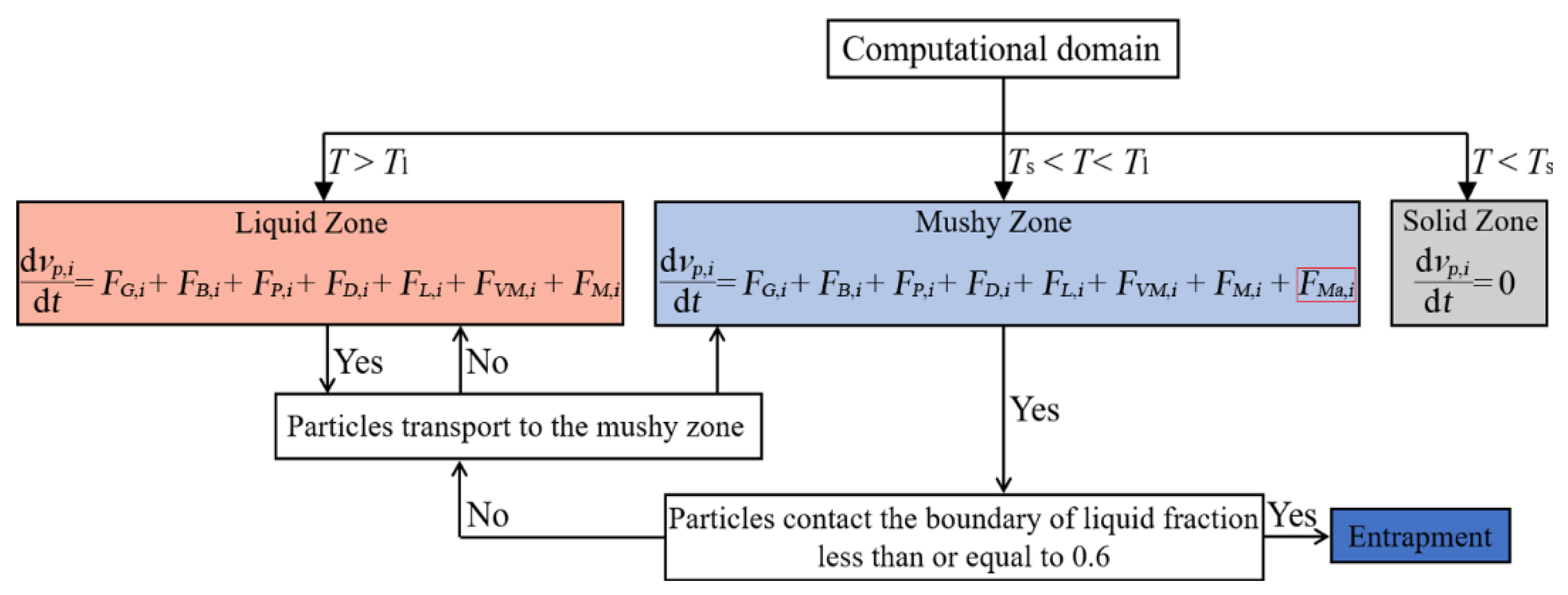
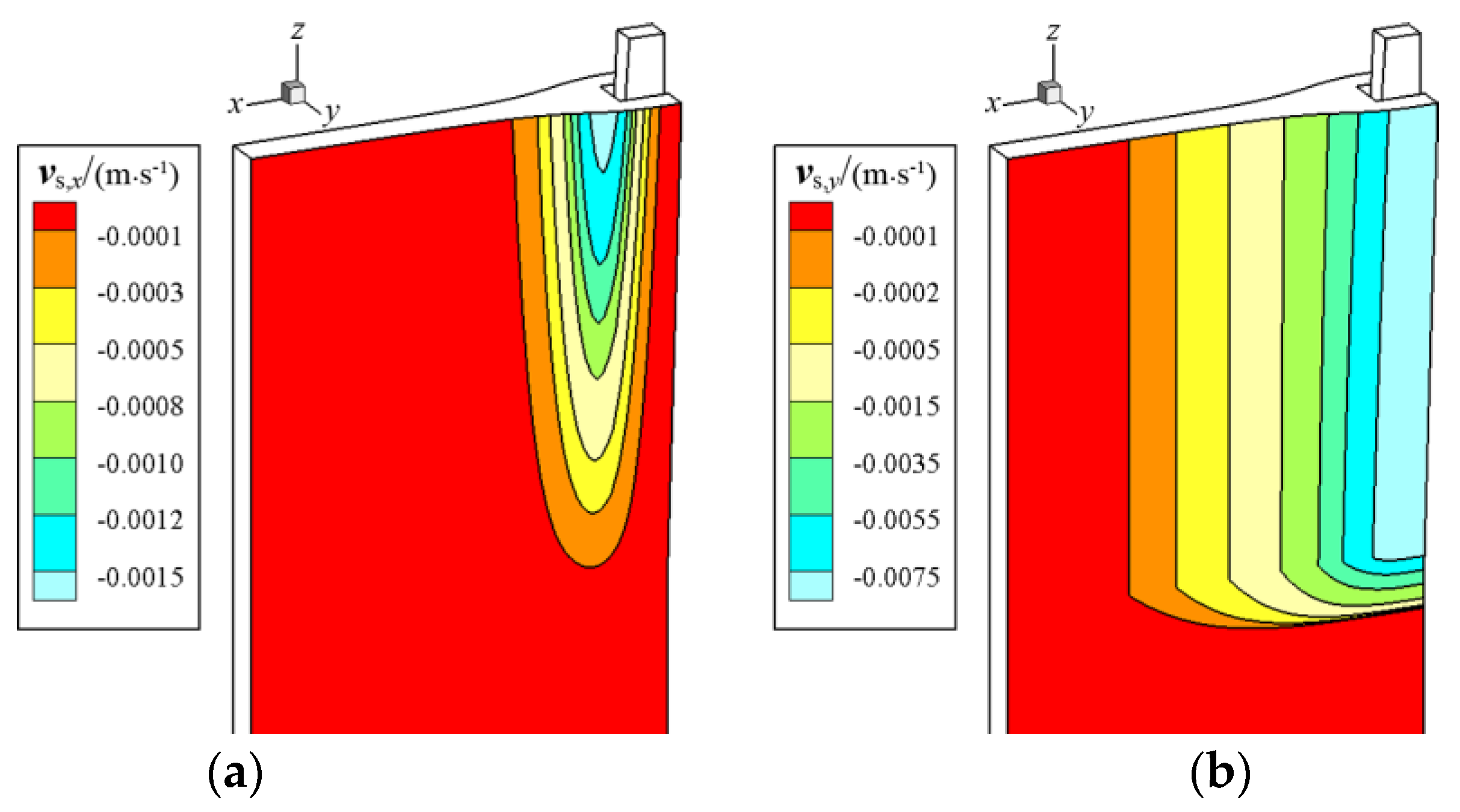
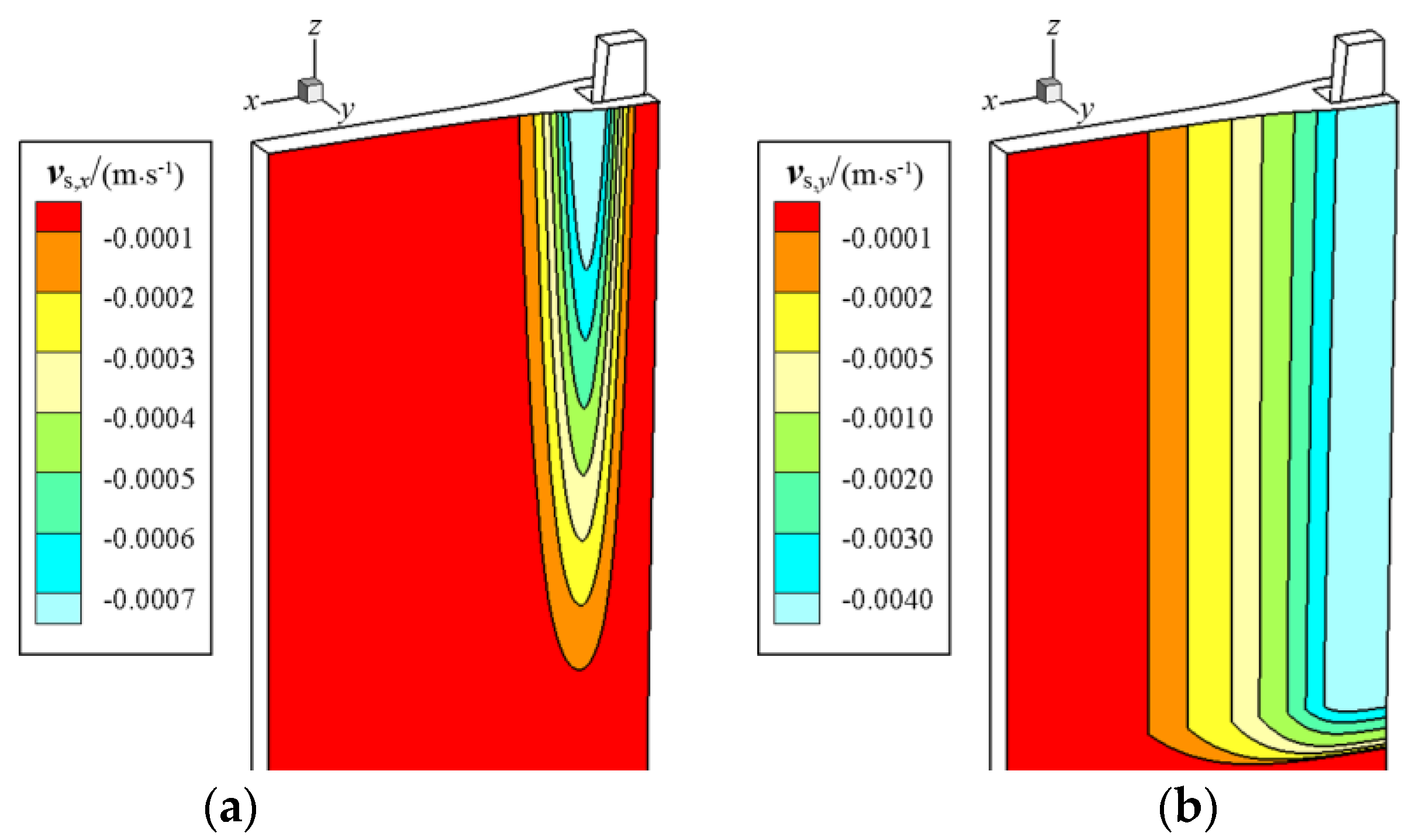



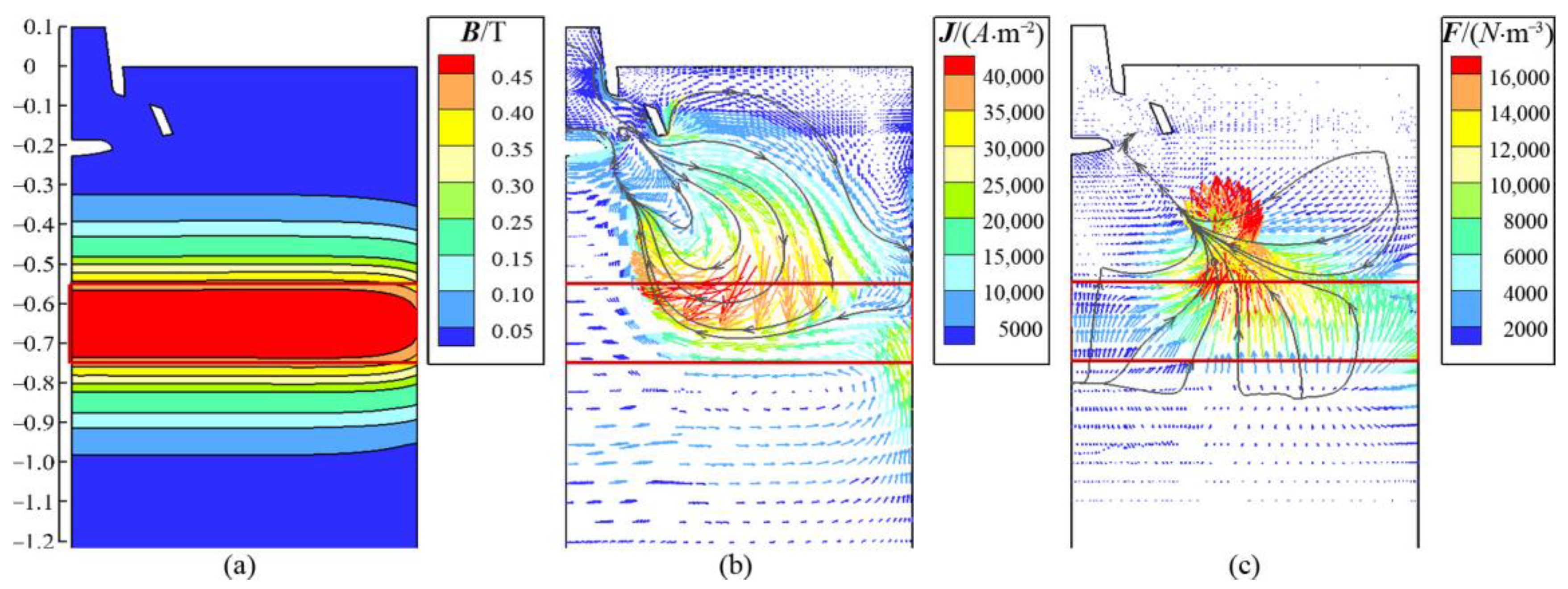
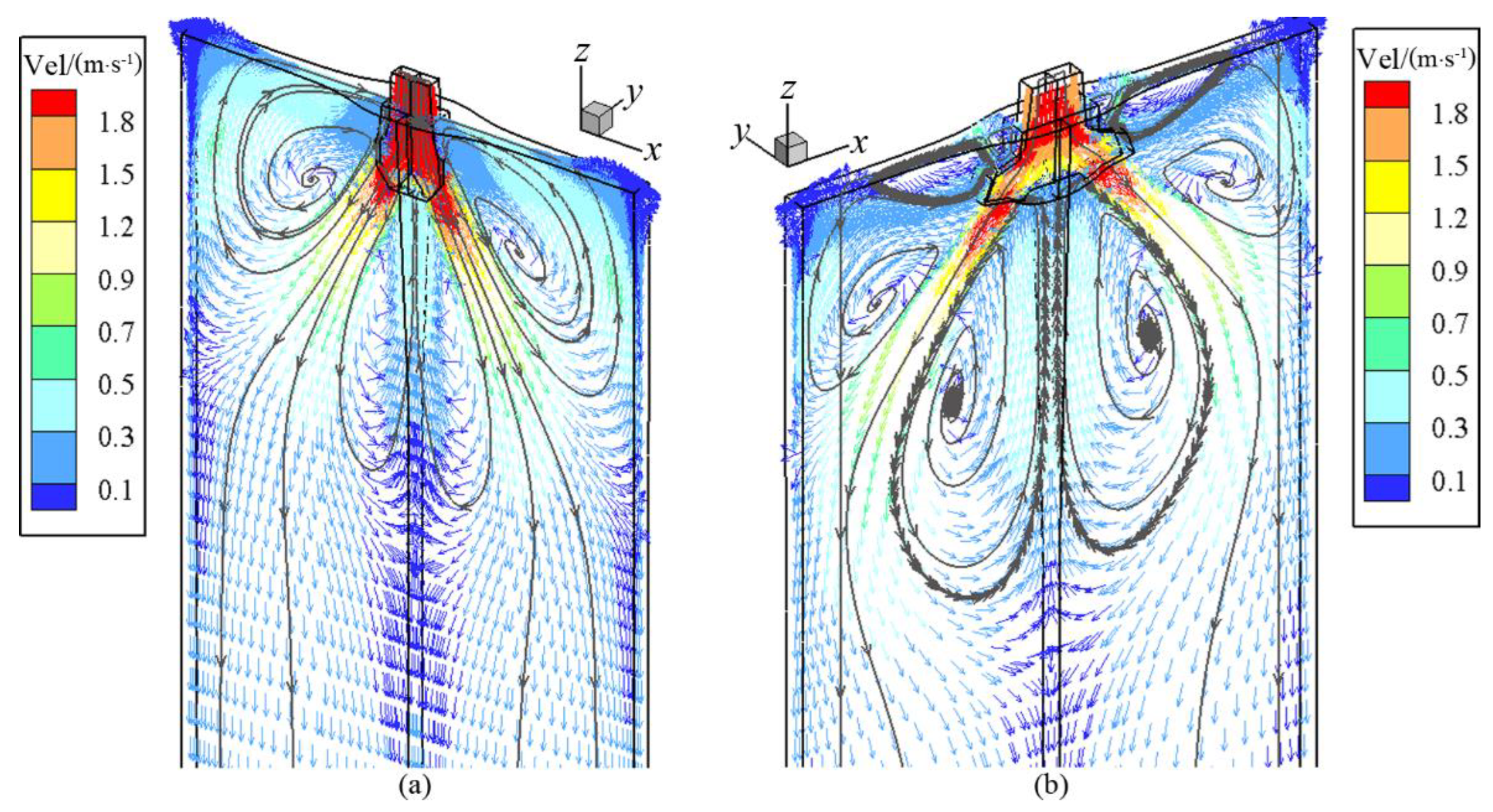
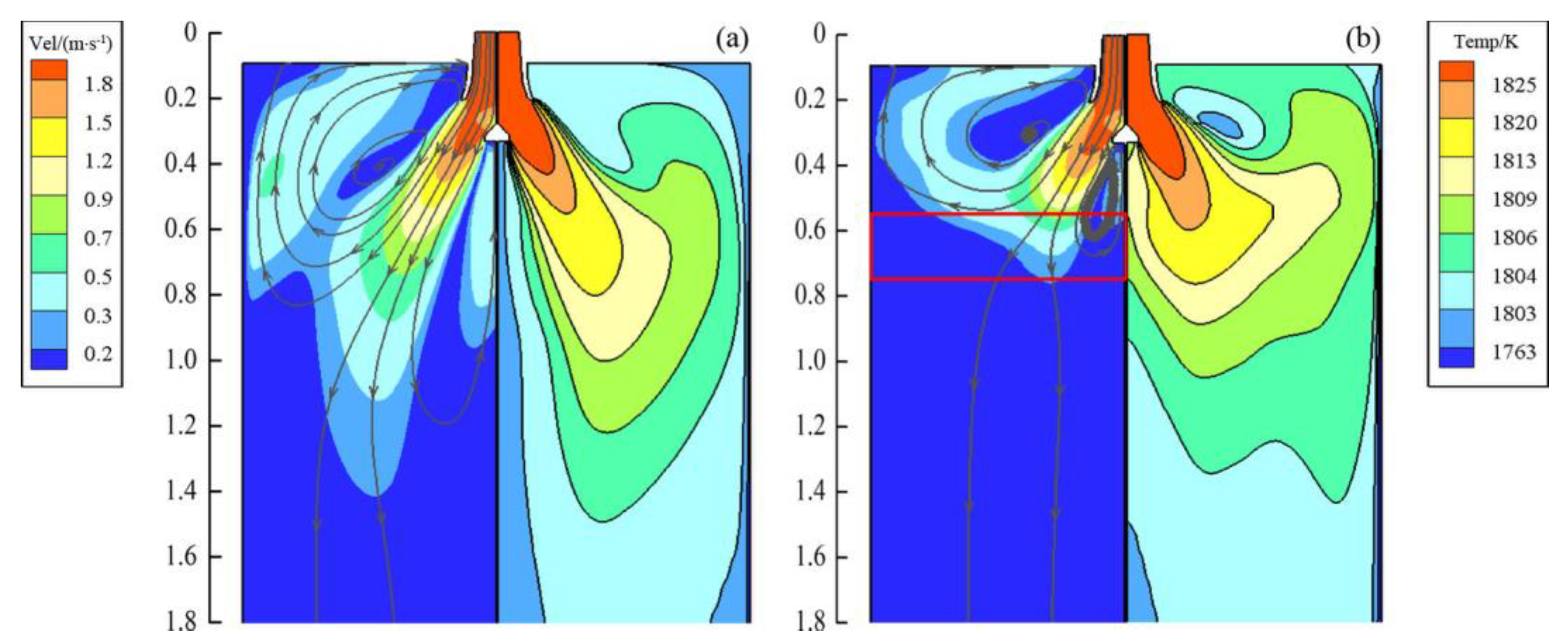

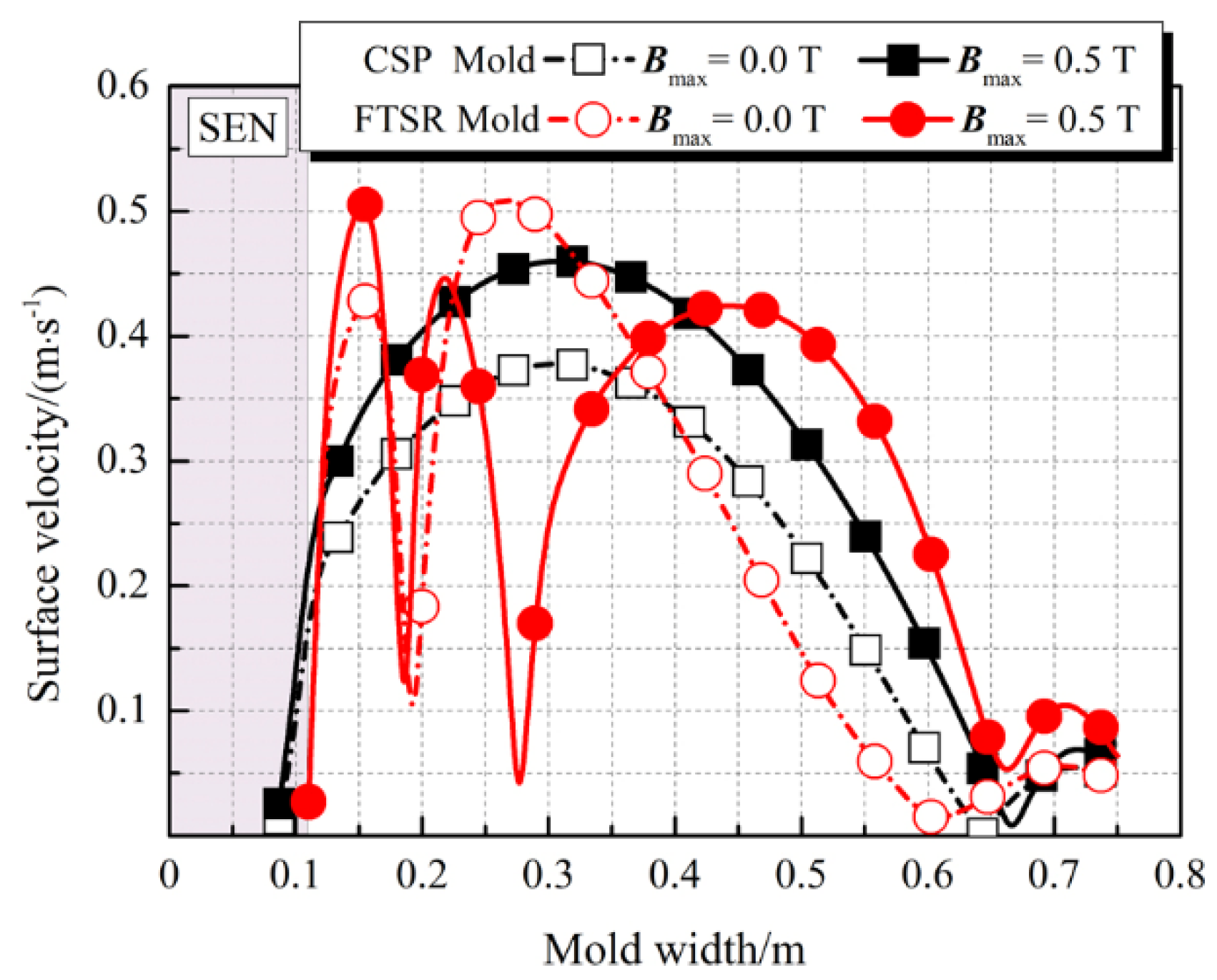

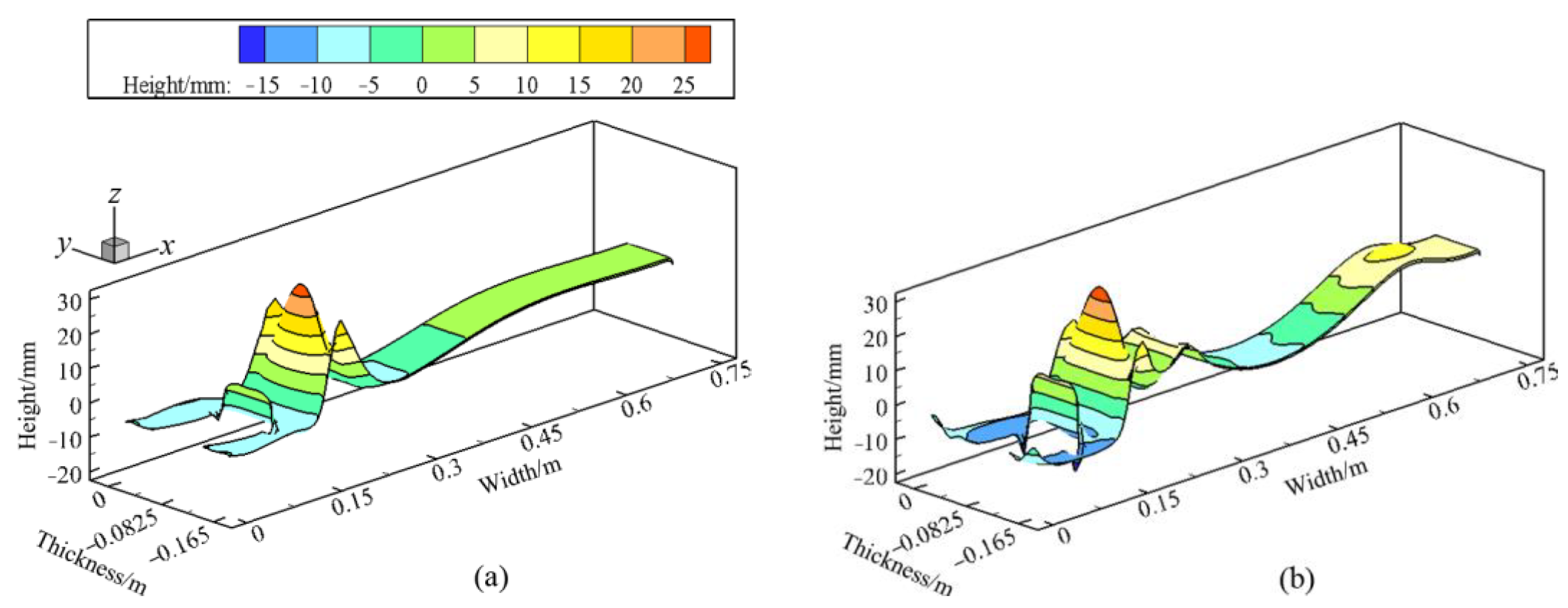

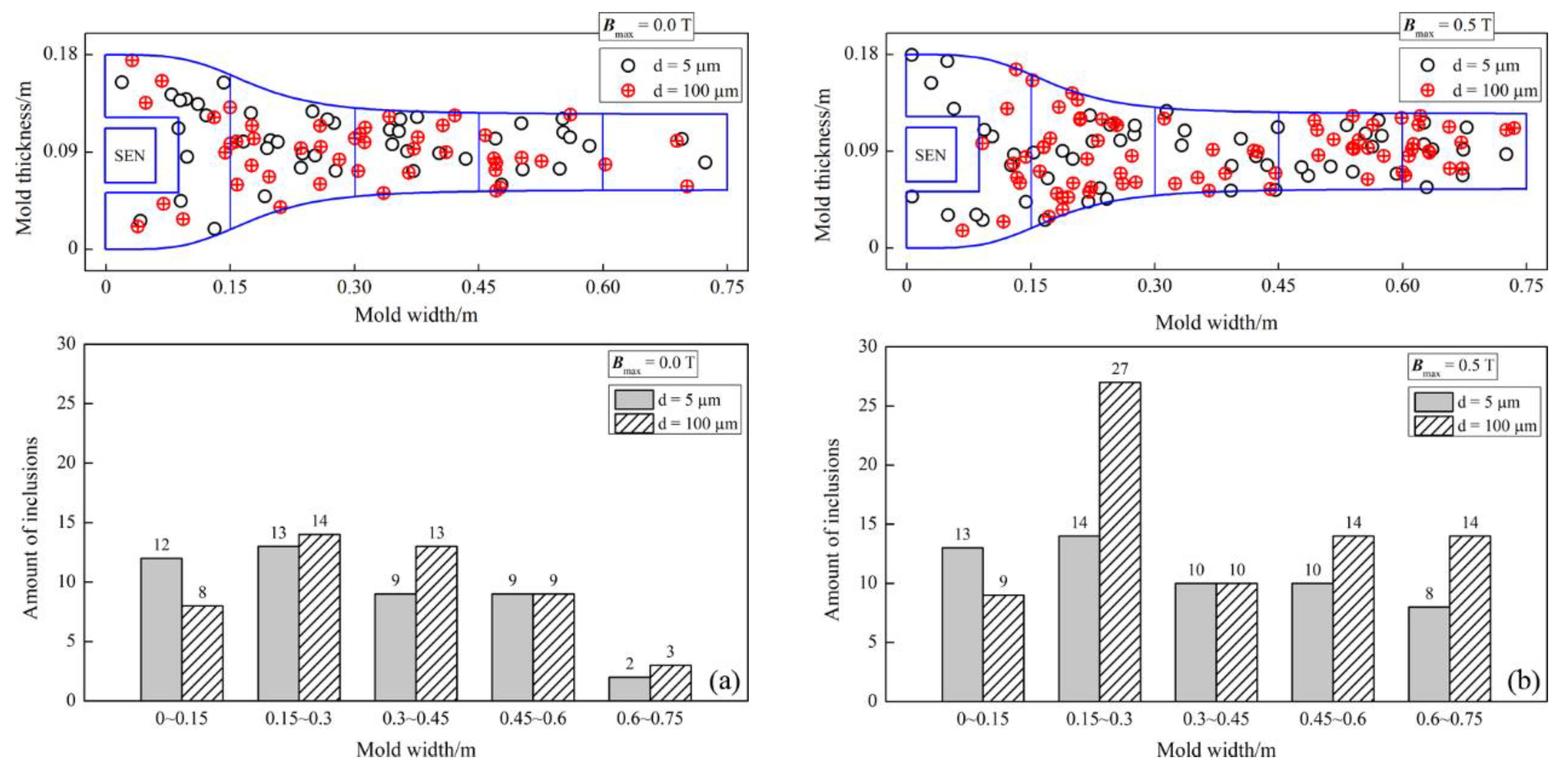
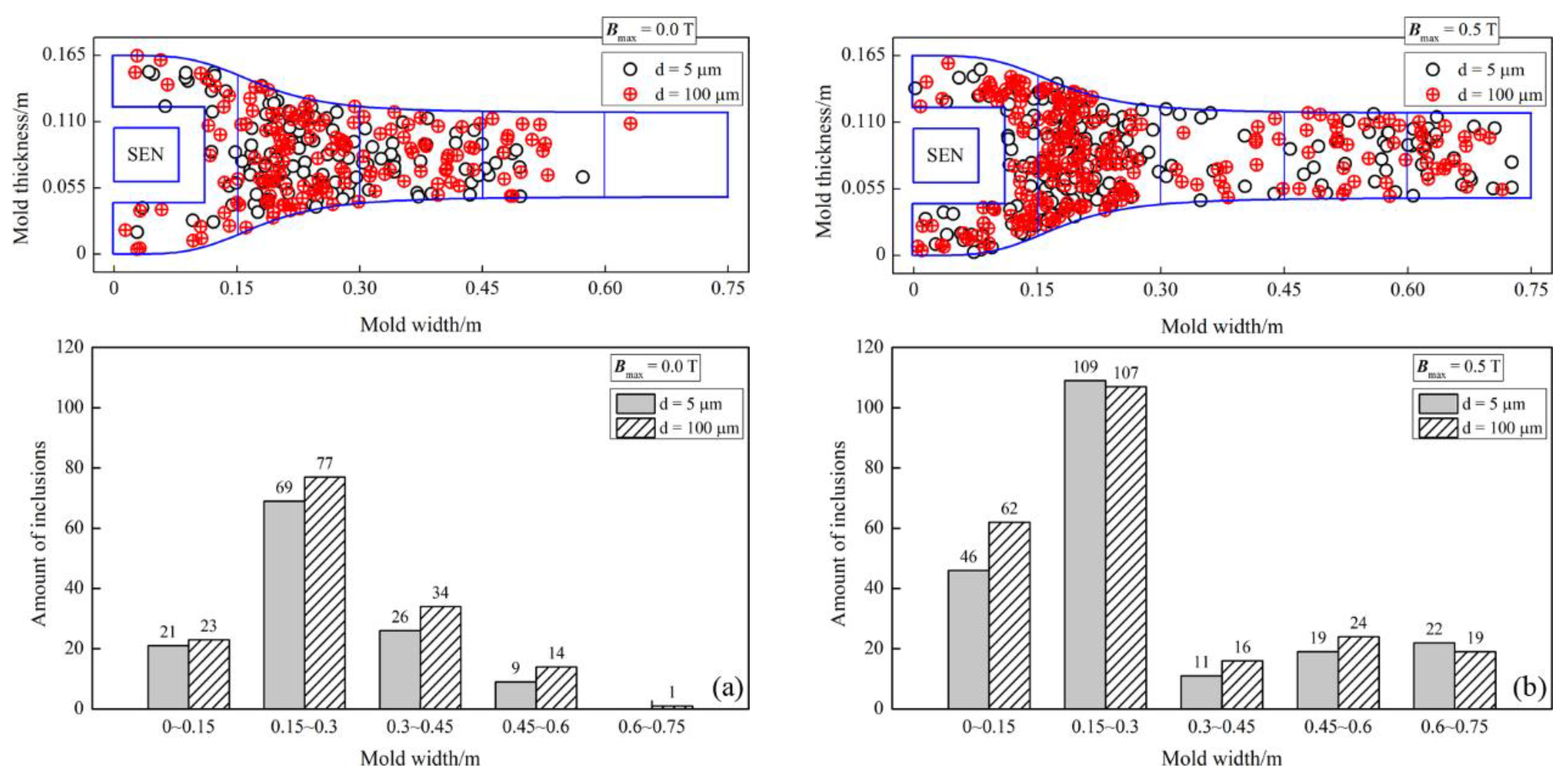
| Casting Parameters of the CSP Mold | |||
| Parameter | Value | Parameter | Value |
| Mold size | 1500 mm × 70 mm | Mold length | 1100 mm |
| Maximum thickness | 180 mm | SEN angle port | −50° |
| SEN depth | 255 mm | Casting speed | 4.5, 7.5 m∙min−1 |
| Casting parameters of the FTSR mold | |||
| Mold size | 1500 mm × 70 mm | Mold length | 1200 mm |
| Maximum thickness | 165 mm | Inlet cross section | 145 mm × 44 mm |
| SEN depth | 225 mm | Casting speed | 4.5, 7.5 m∙min−1 |
| Properties of molten steel | |||
| Steel density | 7020 kg∙m−3 | Solidus temperature | 1763 K |
| Steel viscosity | 0.0062 Pa∙s | Liquidus temperature | 1803 K |
| Specific heat | 720 J∙kg−1∙K−1 | Thermal expansion coefficient | 0.0001 K−1 |
| Thermal conductivity | 27 W∙m−1∙K−1 | Solidification latent heat | 272 kJ∙kg−1 |
| Properties of inclusions | |||
| Specific heat | 860 J∙kg−1∙K−1 | Inclusions density | 5000 kg∙m−3 [25] |
| Inclusions diameter | 5, 100 μm | Number of inclusions | 10,000 |
| Electromagnetic parameters | |||
| Electric conductivity | 7.14 × 105 S∙m−1 | Magnetic flux density | 0.5 T |
| Magnetic permeability | 1.257×10−6 H∙m−1 | Relative permeability | 1000 |
| Error statistics of Solidified Shell Thickness in the CSP Mold | |||
| Mesh | M1 | M2 | M3 |
| Hexahedral cells number | 430,000 | 650,000 | 940,000 |
| Shell thickness/Ti | 12.43 mm | 12.26 mm | 12.22 mm |
| Relative error/δ | – | 1.37 percent | 0.33 percent |
| Fine grid convergence index/GCIfine | – | 0.53 percent | 0.13 percent |
| Coarse grid convergence index/GCIcoarse | – | 2.24 percent | 0.54 percent |
| Error statistics of Solidified Shell Thickness in the FTSR Mold | |||
| Mesh | M1 | M2 | M3 |
| Hexahedral cells number | 540,000 | 860,000 | 1300,000 |
| Shell thickness/Ti | 12.64 mm | 12.56 mm | 12.51 mm |
| Relative error/δ | – | 0.63 percent | 0.40 percent |
| Fine grid convergence index/GCIfine | – | 1.31 percent | 0.83 percent |
| Coarse grid convergence index/GCIcoarse | – | 2.10 percent | 1.33 percent |
Publisher’s Note: MDPI stays neutral with regard to jurisdictional claims in published maps and institutional affiliations. |
© 2022 by the authors. Licensee MDPI, Basel, Switzerland. This article is an open access article distributed under the terms and conditions of the Creative Commons Attribution (CC BY) license (https://creativecommons.org/licenses/by/4.0/).
Share and Cite
Xu, L.; Pei, Q.-W.; Han, Z.-F.; Yang, S.; Wang, J.-Y.; Yao, Y.-T. Modeling Study on Melt Flow, Heat Transfer, and Inclusion Motion in the Funnel-shaped Molds for Two Thin-Slab Casters. Processes 2022, 10, 2738. https://doi.org/10.3390/pr10122738
Xu L, Pei Q-W, Han Z-F, Yang S, Wang J-Y, Yao Y-T. Modeling Study on Melt Flow, Heat Transfer, and Inclusion Motion in the Funnel-shaped Molds for Two Thin-Slab Casters. Processes. 2022; 10(12):2738. https://doi.org/10.3390/pr10122738
Chicago/Turabian StyleXu, Lin, Qun-Wu Pei, Ze-Feng Han, Shuo Yang, Jian-Yu Wang, and Yan-Tao Yao. 2022. "Modeling Study on Melt Flow, Heat Transfer, and Inclusion Motion in the Funnel-shaped Molds for Two Thin-Slab Casters" Processes 10, no. 12: 2738. https://doi.org/10.3390/pr10122738
APA StyleXu, L., Pei, Q.-W., Han, Z.-F., Yang, S., Wang, J.-Y., & Yao, Y.-T. (2022). Modeling Study on Melt Flow, Heat Transfer, and Inclusion Motion in the Funnel-shaped Molds for Two Thin-Slab Casters. Processes, 10(12), 2738. https://doi.org/10.3390/pr10122738







